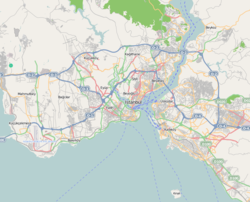Tatavla
| Kurtuluş | |
|---|---|
| Neighborhood | |
| Location of Kurtuluş in Istanbul | |
| Coordinates: 41°02′54″N 28°58′51″E / 41.04845°N 28.98095°ECoordinates: 41°02′54″N 28°58′51″E / 41.04845°N 28.98095°E | |
| Country |
|
| Region | Marmara |
| Province | Istanbul |
| District | Şişli |
| Time zone | EET (UTC+2) |
| • Summer (DST) | EEST (UTC+3) |
| Postal code | 34375, 34377, 34379 |
| Area code | 0-212 |
Kurtuluş, (Turkish for Liberation, Salvation, formerly known as Tatavla meaning "horse stable in Greek: Ταταύλα) is a cosmopolitan neighborhood of Şişli whose population consists of Turks, Greeks (now almost completely emigrated), Armenians (who still live there in numbers), Kurds (who are relatively recent economic migrants), and Jews (who still live there in numbers). The Turkish name means "independence" or "deliverance".
The quarter was originally built in the 16th century as a residential area for Chian Greeks, settled here to work in the principal dockyards of the Ottoman Empire which were situated in the neighboring Kasımpaşa quarter. In 1832, a fire swept and completely destroyed the neighborhood with 600 houses and 30 shops going up in flames. Tatavla emerged as an entirely Greek part of Istanbul, while during the 19th century reached a population of 20,000 and hosted several Orthodox churches, schools and tavernas. It was nicknamed Little Athens due to its Greek character.
The neighborhood's name was changed to Kurtuluş, six years after the Republic of Turkey was founded, for its rebuilding and symbolizing its rejuvenation, after a fire swept and largely destroyed the neighborhood on April 13, 1929, with 207 houses going up in flames. Despite the turmoil of the Balkan War, followed by World War I and the following Greco-Turkish War (1919–1922) and the devastating fire, the neighborhood continued to retain its large Greek population and atmosphere, at least until the riots of 1955. It was typically the residential area for Greeks of more modest income, as opposed to, for example, Tarabya on the Bosphorus, where richer Greeks as well as rich Turks and Europeans lived. Nevertheless, a number of beautiful houses were built in the late 19th century, some of which still stand today.
...
Wikipedia

